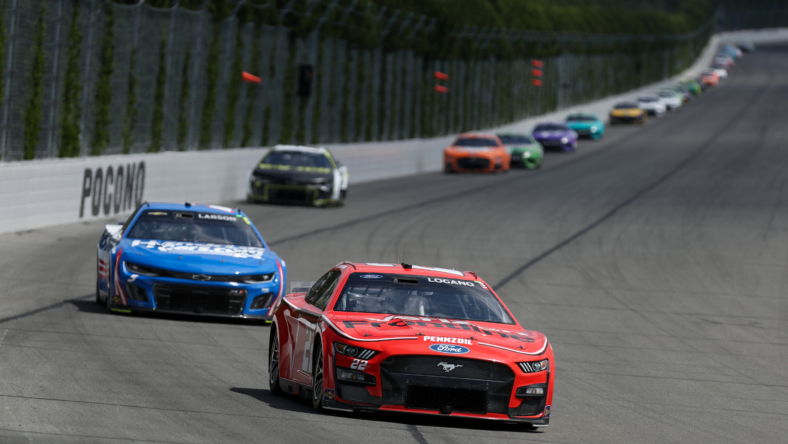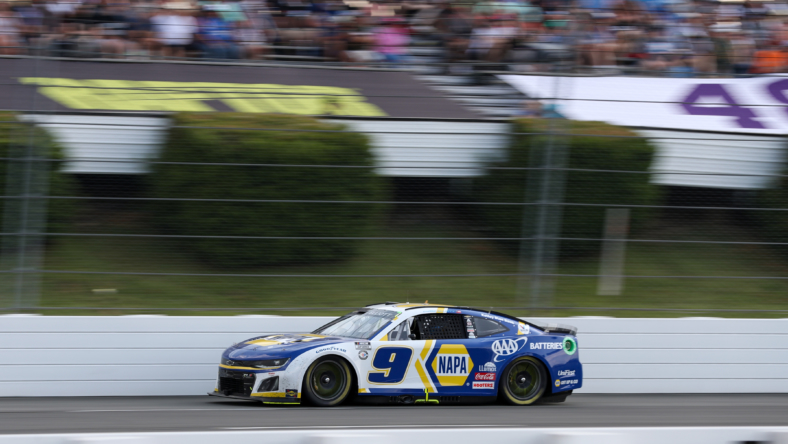
And people say strategy is dead during the stage break era of NASCAR.
It was three laps to go in the first stage of the High Point 400 on Sunday at Pocono and the top-15 were presented with a dynamic decision. Up front, Joey Logano already enjoys the luxury of having won his way into the playoffs and is simply looking for bonus points over the final six races.
Winning this stage would net him one additional stage point, but it will also cost him track position for the start of the second stage, placing him at a potential disadvantage towards winning the race and the five playoff points that come with that too.
Remember that NASCAR playoff points are added to the reset total of championship points at the start of each round so these considerations matter a great deal.
Meanwhile, second place on back are each faced with a different decision based on how their respective seasons have gone thus far. Do they want or need the championship points paid out throughout the Top-10 or do they value track position for the start of the second stage?
Logano stayed out, winning a stage for the third time this season, giving him eight total playoff points when combined with his victory earlier this year at Atlanta Motor Speedway. The likes of Kyle Larson, William Byron, Kevin Harvick, Christopher Bell and Ryan Blaney opted to pit and take what would be track position at the start of the second stage after the leaders made their stops during the stage break.
This jumbled up the running order and led to a series of incidents at the start of the second stage, including one that ended the day for Logano and Daniel Suarez. Logano paid the price for giving up his track position while Suarez, who could have used the stage points, opted for track position and was involved in a crash anyway.
Damned if you do, damned if you don’t, apparently.

There are absolutely inherent flaws with the current NASCAR Cup Series championship format but series officials have found the perfect balance between rewarding season long excellence while creating the dramatics associated with eliminations over the final 10 weeks.
The regular season points battle matters right now because the Top-10 in points after the 26th race are rewarded with 15, 10, 8, 7, 6, 5, 4, 3, 2 and 1 playoff point, respectively, in addition to what they earned throughout the regular season.
Look at that battle:
- 1. Martin Truex Jr.
- 2. William Byron -30
- 3. Denny Hamlin -55
Don’t forget that those five, two or one-point differences have been the point of separation in deciding who advances to the penultimate or championship rounds over the past seven years.
Are you amongst those who think the 20 stage points handed out a third and halfway through the race don’t matter in the grand scheme of things? Think again. Look at the current provisional playoff bubble with five races remaining until The Great Reset.
- 15. Bubba Wallace +26
- 16. Michael McDowell +17
- 17. AJ Allmendinger -17
- 18. Daniel Suarez -23
- 19. Ty Gibbs -28
- 20. Alex Bowman -45
Now let’s go back to that strategic divergence approaching the first stage break for a moment. Before the decision, look who was running near the Top-10, in position to score much needed stage points towards their NASCAR Cup playoff hopes:
- 10. AJ Allmendinger
- 11. Michael McDowell
- 12. Bubba Wallace
With some of the leaders choosing track position, making their stops before pit road closed with two laps remaining in the stage, Allmendinger ended up advancing all the way to fifth by the green-white checkered flag and scored five points as a result. McDowell finished sixth with four points and Wallace finished seventh and scored three points.

Sure, that particular stage break didn’t create any separation in the standings but that’s the race within the race each week over the next five weeks. For those who think Cup races are entirely too long, these are the subplots worth following from week-to-week because there is so much drama approaching every single segment in which points get paid out during a race.
This is to say nothing of having two road courses and a superspeedway race remaining over the final five races, tracks that could produce a new winner from outside of the current Top-16 and creating one less position to make the playoffs on championship points.
Don’t forget that Chase Elliott and Alex Bowman now faced must-win scenarios alongside Aric Almirola, Ryan Preece, Chase Briscoe, Corey Lajoie and Justin Haley — drivers who could realistically win at Richmond, Michigan, Indianapolis Road Course, Watkins Glen or Daytona.
That’s the macro picture.
But again, from a micro standpoint, this race and championship format has been a significant boon towards the racing at Pocono in recent years. While the Tricky Triangle has no shortage of proponents, the races there have long been best described as procedural.
The opportunity for obvious contenders to take a playoff point, with others choosing to take track position after the stage break and other fringe contenders looking to pick off the scraps of stage points is adding a lot of intrigue to the races in the second half of the NASCAR Cup regular season.
As Logano can attest, losing the track position created a disadvantage and ultimately led to him crashing on Sunday afternoon, but that playoff point very well could give him a chance to repeat as series champion at Phoenix in November, too.
The dynamic constantly reshuffled the running order and arguably created the action that defined the race on Sunday.
But sure, strategy is dead in the NASCAR Cup Series, or something.
Matt Weaver is a Motorsports Insider for Sportsnaut. Follow him on Twitter.

